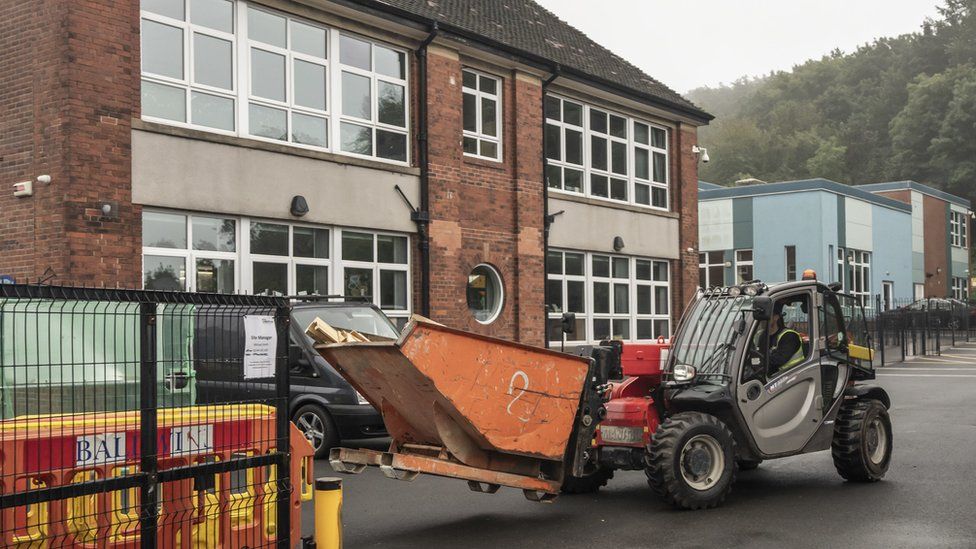
More than 100 schools in England have been ordered to partially or completely close buildings due to concerns that the concrete they are built with is not safe.
We put to Professor Chris Goodyear, concrete expert at Loughborough University, BBC Education correspondent Hazel Shearing, and BBC Head of Education News Alice Evans, to find out what this means for you.
Why were the schools built like this?
There is nothing fundamentally wrong with the use of RAAC as a building material or system. Many buildings from the 1960s and 1970s built of many materials are now facing problems due to inadequate maintenance and aging. Many of the RAAC’s buildings are over 50 years old and in good condition.
No substance has an ideal lifespan. And even if they were built in the same way, the health of the buildings would be in different circumstances – some would be good and others would suffer.
Will more schools have to be closed?
The short answers are a) yes, and b) no.
The Department for Education (DfE) has not provided an exact number of schools that must close as a result of Thursday’s announcement.
Schools with a RAAC are only required to close or partially close if they do not have safety measures in place, and cannot make alternative arrangements – such as converting other parts of the building into temporary classrooms or moving children to another location.
A total of 156 schools have confirmed RAAC. Of these countries, 52 countries have already implemented safety measures. The other 104 are currently working to put in place safety measures to remain open – as many as 24 of them may have to close completely.
But hundreds of other schools have yet to figure out whether or not they have a RAAC. Last June, a report by the National Audit Office assessed that 572 schools had been identified where the RAAC might exist.
The government did not say when the list of affected schools would be published
How do I know if my child’s school is closed?
If your school is closed, they must contact you directly.
On Thursday, Education Minister Gillian Keegan said affected schools would be communicating with parents directly, adding: “If you haven’t heard, don’t worry.”
Affected schools will do their best not to close completely. Some pupils have already been told that they will learn remotely, in temporary classrooms or in different schools.
Since the government has not yet published a list of affected schools, BBC News has carried out its own searches. The affected schools that we know of are listed here.
Is this problem only in schools?
no. Many public buildings have been identified as being at risk due to the RAAC, including hospitals and police stations.
Why is the government blamed?
The government says it has advised schools to take “adequate emergency measures” since 2018, in case damaged buildings need to be evacuated.
But one of the reasons for her criticism is that she had no idea of the scale of the problem at the time.
It is difficult for schools to determine whether or not their buildings contain RAAC because it looks like regular concrete.
Many probably didn’t know they had it in 2018 as engineers are needed to confirm it.
It wasn’t until 2022 – four years later – that the DfE sent out a questionnaire to schools asking if they had any confirmed or suspected cases of RAAC. If the school says yes, DfE will send engineers to confirm this.
Another problem here is changing orientation days at the last minute before the start of the new term.
Previously, schools with a confirmed RAAC that were thought to present a non-critical risk were told to have emergency procedures in place should buildings need to be closed.
They were only told to close those buildings on Thursday unless safety measures were taken, meaning principals must now scramble to find alternative plans.
Why was this not resolved during the covid pandemic?
Ministers might say that the reason the construction did not happen earlier is that they were not aware of the problem in these particular schools until very recently.
The government says it has advised schools to take “appropriate emergency measures” since 2018, in case damaged buildings need to be evacuated.
But just this summer, various incidents – including a collapsed girder in a building – led the government to decide that some of the RAAC’s previously deemed low risk were actually dangerous.
That is why they have now issued a more serious warning that affected schools must put in place safety measures or close the affected part of their buildings.
Why is routing different in Scotland?
The change of direction only applies to England at this point. We do not yet have a complete picture of the situation in the rest of the UK.
Scotland has already started RAAC inspections of its school buildings, and a full report on the number of schools affected in Scotland is due to be submitted to the government soon.
According to the Liberal Democrats, the RAAC is found in at least 37 schools in Scotland.
The Welsh Government has said it will be scanning schools and colleges in the country to check if any are made with RAAC. In Northern Ireland, surveys are taking place.
The reason why it may differ depending on where you live is that education is administered by the devolved governments in every country.
Questions have been asked by readers including Christopher Grierson, Frederick Butt, Amanda Elvis and Ray Chester.